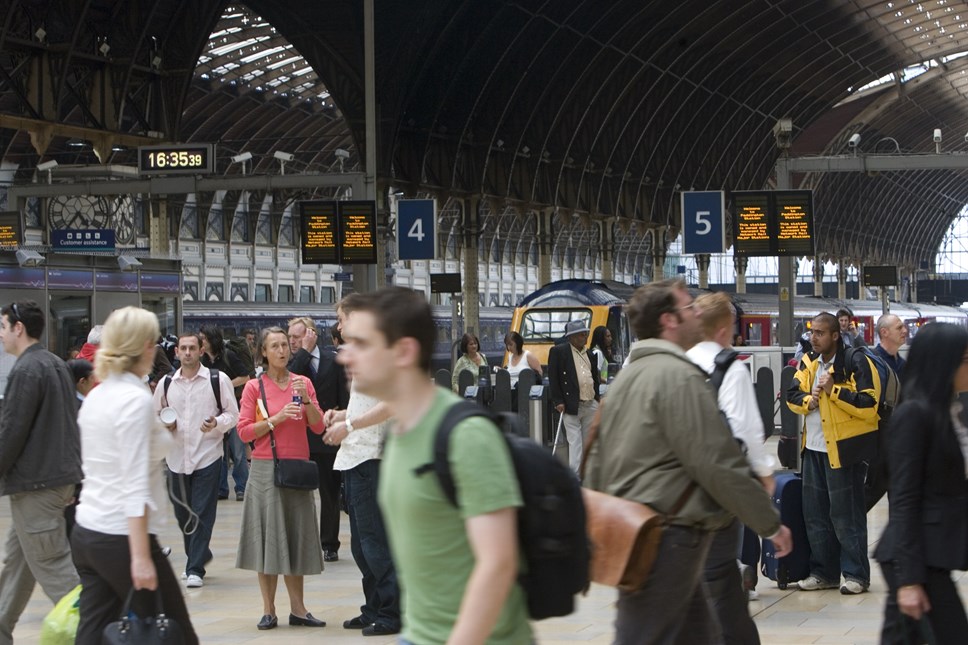
Rest and recreation tops reasons for train trips – new analysis
- Great British Railways Transition Team (GBRTT) shares the first Train Travel Snapshot showing a national picture of train journeys by purpose.
- Latest figures underline the importance of leisure travel to railway revenue. Trips for leisure made up for over half (54%) of industry revenue in the quarter, despite the usual post-summer dip and impacts from 11 days of industrial action*.
- Business travel revenue was up 6% on the previous quarter, but still accounts for a small share of the overall market.
- The second stage of opening the new Elizabeth line in November (Reading, Heathrow, and Shenfield connecting directly to central London) helped lift National Rail revenue from commuting by 3%.
Great British Railways Transition Team (GBRTT) is today (24 March) publishing the first Train Travel Snapshot – an analysis of passenger journey purpose throughout England, Scotland and Wales.
The Government has tasked GBRTT with leading the industry’s recovery from the pandemic, alongside delivering much-needed reform to create a simpler, better railway for everyone in Britain.
GBRTT has worked with the industry regulator; the Office of Rail and Road (ORR), as well as the Department for Transport and Rail Delivery Group, to deliver this new insight, which not only seeks to understand the reasons people are taking the train and any changes over time, but also implications and opportunities for industry revenue.
This deeper understanding of rail’s customers will help to shape effective reform of our railways, recognising that people have more choice than ever over whether and how to travel.
Suzanne Donnelly, Director of Passenger Revenue at the Great British Railways Transition Team, said: “The final quarter of last year saw journey patterns begin to settle down as customers found a rhythm that made most sense for them after the upheaval of the pandemic. Our first Train Travel Snapshot shows clearly that leisure is the most popular reason to take a trip by rail, whether that’s spending time with friends and family or visiting new places.
“Still, we see plenty of opportunity to entice commuters and business travellers back, as well as to grow the leisure market further, with simpler fares and the right products to meet customers' needs as they stand today.
“We’re working with the Department of Transport and across the industry to do just that, for example testing single-leg pricing.”
GBRTT has brought the rail industry together to spearhead national marketing campaigns encouraging more people to travel by train, more often. That includes initiatives like the Great British Rail Sale, which successfully encouraged millions to take a trip they otherwise wouldn’t.
GBRTT’s Train Travel Snapshot will be released quarterly to complement the publication of rail passenger use data by the Office of Rail and Road.
GBRTT’s Train Travel Snapshot
| Journey purpose | Revenue | Revenue change from last quarter | Number of journeys | |
|
2022-23 Quarter 3: 1 Oct – 31 Dec |
Business | £179 million | +£10 million (+6%) | 24 million |
| Commute | £781 million | +£20 million (+3%) | 131 million | |
| Leisure | £1,139 million | -£199 million (-15%) |
214 million |
Notes to editors
* 11 days of industrial action includes:
- 1, 5, 8 October,
- 5, 7 November – although cancelled by RMT, these days were heavily disrupted; we have excluded the 9 Nov when a reasonably normal service ran
- 26 November
- 13, 14, 16, 17 December
- 24 December – although the strike was officially from 1800, only around 50% of usual Saturday trains ran
GBRTT’s Train Travel Snapshot Methodology
National industry revenue and journeys figures are taken from those published by ORR each quarter. These figures and the methodology used to infer them can be found on the Passenger Rail Usage page of ORR’s data portal.
Data from the Wavelength survey has been used by GBRTT’s Passenger Revenue team to infer an estimated split of revenue and journeys by market for each quarter. These proportions have been applied to the overall ORR revenue and journeys figures. All revenue data is presented in October to December 2022 prices.
The statistics for 2022-23 Quarter 3 (1 October 2022 to 31 December 2022) were published by ORR on 16 March 2023, and so the figures presented in this report represent the latest available data.
The definition of business, leisure and commuter travellers is based on responses from the Wavelength survey:
- A business traveller is someone who is travelling on company business, i.e. for a work meeting
- A commuter is someone who is travelling to or from their usual place of work or education
Leisure passengers include those travelling for personal leisure reasons (e.g. visiting friends or family, days out, shopping, entertainment, sports activities, etc) plus people travelling for personal business reasons (e.g. a health appointment, a job interview or other appointment).
